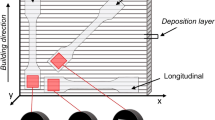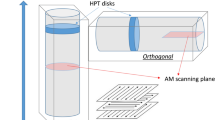Abstract
Additive Manufacturing (AM), for the case of metals, is a technology developed to create 3D products by following a layer-by-layer welding procedure. In this work, the tensile behavior of wire arc additively manufactured mild steel is studied experimentally and numerically. The microstructure of the metal is strongly influenced by the AM process that involves several heating and cooling cycles; therefore, it is first analyzed with optical microscopy, scanning electron microscopy, energy-dispersive X-ray spectroscopy and X-ray diffraction to identify the different phases and to extract the grain properties. With this information, two approaches are used to build the Representative Volume Element, which will be part of a multi-scale material model. The first approach constitutes a synthetic generation of grains according to a Voronoi Tessellation and the second one an image-based representation. Afterwards, a virtual tensile test for the determination of the stress–strain relation of the material is performed, which is later compared with the measurements of a real tensile test carried out on several specimens that were obtained using the wire arc additive manufacturing technique.
It can be observed that the influence of the welding direction on the stiffness and the ductility of the additively manufactured steel product is rather low, yielding similar results in both parallel and perpendicular directions. Additionally, a softening behavior of the material is noticed.












Similar content being viewed by others
References
Moeini G, Ramazani A, Hildebrand J, Roessler C, Koenke C (2018) Study of the effect of microstructural variation on the low cycle fatigue behavior of laser welded DP600 steel: simulation and experimental validation. Mater Sci Eng A 730:232–243. https://doi.org/10.1016/j.msea.2018.06.004
Pan Z, Ding D, Wu B, Cuiuri D, Li H, Norrish J (2018) Arc Welding Processes for Additive Manufacturing: A Review. In: Chen S, Zhang Y, Feng Z (eds) Transactions on Intelligent Welding Manufacturing, vol 81. Singapore, Springer Singapore, pp 3–24
Ali Y, Henckell P, Hildebrand J, Reimann J, Bergmann JP, Barnikol-Oettler S (2019) Wire arc additive manufacturing of hot work tool steel with CMT process. J Mater Process Technol 269:109–116. https://doi.org/10.1016/j.jmatprotec.2019.01.034
Williams SW, Martina F, Addison AC, Ding J, Pardal G, Colegrove P (2016) Wire + arc additive manufacturing. Mater Sci Technol 32(7):641–647. https://doi.org/10.1179/1743284715Y.0000000073
Diegel O, Wohlers T (2018) Additive manufacturing: myths, misconceptions and untruths 4(3):169–173
Suryakumar S, Karunakaran KP, Chandrasekhar U, Somashekara MA (2013) A study of the mechanical properties of objects built through weld-deposition. Proc Inst Mech Eng Part B J Eng Manuf 227(8):1138–1147. https://doi.org/10.1177/0954405413482122
Colegrove PA, Coules HE, Fairman J, Martina F, Kashoob T, Mamash H, Cozzolino LD (2013) Microstructure and residual stress improvement in wire and arc additively manufactured parts through high-pressure rolling. J Mater Process Technol 213(10):1782–1791. https://doi.org/10.1016/j.jmatprotec.2013.04.012
Ding J, Colegrove P, Mehnen J, Ganguly S, Sequeira Almeida PM, Wang F, Williams S (2011) Thermo-mechanical analysis of wire and arc additive layer manufacturing process on large multi-layer parts. Comput Mater Sci. https://doi.org/10.1016/j.commatsci.2011.06.023
Quey R, Dawson PR, Barbe F (2011) Large-scale 3D random polycrystals for the finite element method: generation, meshing and remeshing. Comput Methods Appl Mech Eng 200(17–20):1729–1745. https://doi.org/10.1016/j.cma.2011.01.002
Schneider CA, Rasband WS, Eliceiri KW (2012) NIH Image to ImageJ: 25 years of image analysis. Nat Methods 9(7):671–675. https://doi.org/10.1038/nmeth.2089
Langer SA, Fuller ER, Carter WC (2001) OOF: an image-based finite-element analysis of material microstructures. Comput Sci Eng 3(3):15–23. https://doi.org/10.1109/5992.919261
Reid ACE, Langer SA, Lua RC, Coffman VR, Haan S-I, García RE (2008) Image-based finite element mesh construction for material microstructures. Comput Mater Sci 43(4):989–999. https://doi.org/10.1016/j.commatsci.2008.02.016
Reid ACE, Lua RC, Garcia RE, Coffman VR, Langer SA (2009) Modelling microstructures with OOF2. IJMPT 35(3/4):361. https://doi.org/10.1504/IJMPT.2009.025687
Rodriguez R-M, Gutiérrez I (2003) Unified formulation to predict the tensile curves of steels with different microstructures. MSF 426–432:4525–4530. https://doi.org/10.4028/www.scientific.net/MSF.426-432.4525
Ma S, Zhuang X, Zhao Z (2016) Effect of particle size and carbide band on the flow behavior of ferrite-cementite steel. Steel Res Int 87(11):1489–2150. https://doi.org/10.1002/srin.201500438
Dongare S, Sparks T, Newkirk J, Liou F (2014) A mechanical testing methodology for metal additive manufacturing processes. In: Annual international solid freeform fabrication symposium 2014, 224–242
Buchanan C, Matilainen V-P, Salminen A, Gardner L (2017) Structural performance of additive manufactured metallic material and cross-sections. J Constr Steel Res 136:35–48. https://doi.org/10.1016/j.jcsr.2017.05.002
Acknowledgements
The work has been financially supported by the Federal State of Thuringia, Germany, within the research group: ‘’Characterization and functionalization of materials and component parts’’, which is highly acknowledged. The cooperation from TU Ilmenau, through the FG Fertigungstechnik (Univ.-Prof. Dr.-Ing. habil Jean Pierre Bergmann), who provided the 3D printed material for the experiments is also gratefully acknowledged.
Author information
Authors and Affiliations
Corresponding author
Additional information
Publisher’s Note
Springer Nature remains neutral with regard to jurisdictional claims in published maps and institutional affiliations.
Rights and permissions
About this article
Cite this article
Lizarazu, J., Göbel, L., Linne, S. et al. Experimental characterization and numerical analysis of additively manufactured mild steel under monotonic loading conditions. Prog Addit Manuf 5, 295–304 (2020). https://doi.org/10.1007/s40964-020-00111-z
Received:
Accepted:
Published:
Issue Date:
DOI: https://doi.org/10.1007/s40964-020-00111-z




